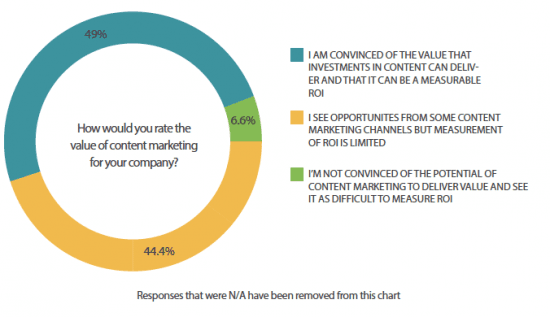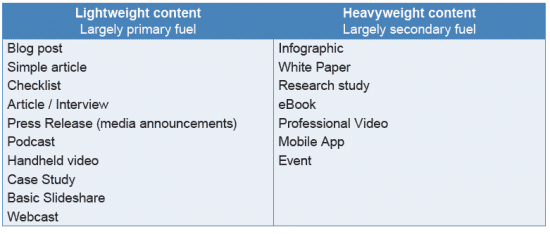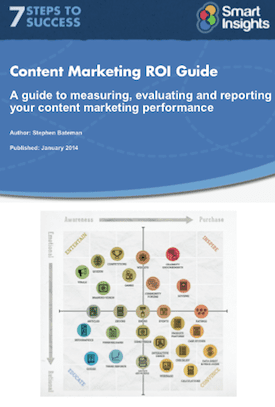Content marketing works, but measuring content marketing ROI is challenging
In the Smart Insights-Hubspot research into content marketing in Europe, 44.4% of marketing managers who responded to the survey, say they struggle to measure the return on their content marketing investment.

44.4% of marketing managers struggle to measure content ROI
This inability to measure the ROI of content marketing confirms a need for more guidance on how to calculate the cost of content marketing and measure the return on investment.
In this post I want to walk you through a simple but effective costing model, and show you how, by breaking out the component costs of content into labour, production and distribution, you can work out your content marketing cost, which provides the basis for evaluating your content marketing ROI.
Content marketing cost
Broadly speaking, content marketing can be divided into 5 cost centres:

Content Marketing: 5 Cost Centres
Some of the costs in content marketing are one-offs (e.g generating personas, mapping buyer journeys, content governance), whilst other costs are recurrent costs incurred on every content project. The point is you need to attribute some costs to overhead.
Labour costs
Working on content marketing is labour-intensive (learn more about the people and roles), and although a degree of automation can be brought in (this also costs), automation is for larger organisations that can scale the process.

The people in a content marketing team
In some instances some key labour tasks might be outsourced to experts. This is advantageous at the outset.
Cost of producing content
To calculate product or creation costs, content can be divided broadly into two types of content:
a) lightweight, frequent, and by definition, less demanding to create, and
b) heavyweight, with greater, longer lasting impact.

The two categories of content
In his book ‘Launch’ Michael Stelzner, founder of the Social Media Examiner website, attributes his marketing success to two forms of content that he created and gave away to attract customers: ‘Primary fuel’, content he created to keep his business moving forward and ‘Nuclear fuel’, the special content he used to attract the hundreds of thousands of visitors per month, many of whom later gladly purchased his services.
Primary fuel / Lightweight content
Primary fuel is regularly published, free or low-cost content that meets the needs of your audience. The goal of your primary fuel is to help solve your readers’ problems so they will become fans and advocates.
Nuclear fuel / Heavyweight content
Nuclear fuel is carefully designed content with a higher production cost that is designed to have a lasting impact on significant numbers of your ideal reader base and possibly experts.
Your content marketing goals and strategy will dictate whether you choose to put more effort on lightweight or heavyweight content. That should be a big question for you! Let’s now examine the cost of producing and distributing both lightweight and heavier content.
How to cost content
Let’s assume your company decides to invest three solid, 600-900 word, blog posts per week, sourced either from experts, or from members of the senior team.
A solid blog post takes an average five hours to research, write, and edit.
Let’s assume that the average annual earnings of a solid blogger (external or on the senior team) is £45,000 annum
If that person works 45 weeks in the year and 48 hours per week their hourly cost is £45,000/2160 hours = £20.83 per hour
Hourly expense of a solid blogger = £20.83 (NB this includes no charges or overhead)
Therefore, the cost of one blog post is equal to £20.83 x 5 = £104.15
The annual cost of blogging at this frequency is £104.15 x 3 blogs week = £312.45 x 45 weeks = £14,060.45 per annum (not including overhead)
Consider the role of content curation
It’s not the case that unique, original content always gives the best returns. Curating content, sharing infographics, data and visuals from others may be more cost effective and can still present a brand well if it adds value.
The cost of producing heavyweight “Epic or Nuclear” content
You can apply the same framework as above to calculate the production costs of heavyweight content. I’ve chosen to restrict the detail in this post to lightweight content, but paid Expert members can access the calculation for epic content in the Expert guide.
The advantage of investing epic content is that you can “atomise” it to produce a multitude of “spin-off” content for other channels.
The cost of content distribution
Content creation and content distribution are married at the hip and so is their cost. In fact there is no point in creating content if you’re not planning to promote it extensively.
Content distribution includes a wide range of activity from community building activities such as moderating discussions and commenting on influential blog posts to tweeting and building relations with influencers on Twitter and LinkedIn. There is also paid promotion of content through Google AdWords and advertising social networks.
In essence promotion is executing a plan that uses content as social bait to build customer relations, customer leads, sales and advocacy.
For the sake of this costing exercise let’s assume two members of your team spend 90 minutes on content promotion per workday, each.
Let’s assume that the average annual earnings of a social media / community manager (internal or agency) is £40,000 per annum
Hourly cost of that person is £40,000/2160 hours = £18.52 per hour (without charges or overhead)
Therefore, the cost of promoting content is £18.52 x 1.5 x 2 (people) x 225 days = £12,501 per annum (in this case there is no paid content promotion)
To this cost we’ll add an hour per week for measuring, evaluating and reporting on metrics £18.52 x 45 weeks = £833
You may also add in some cost for graphic design and for more junior contributions. The point is this method of cost calculation offers an effective and flexible costing framework for both content marketing and social media promotion.
To sum up, based on our calculations, your content marketing is costing you
£14,060.45 (lightweight content)
£6,019 (Heavyweight content) * Expert members can view details of this calculation in the guide
£12,501 (Content Promotion)
£833 (Measurement)
£33,413.45 (Subtotal)
£8,353.56 (Overhead @ 25%)
£41,766,81 Total Cost
Viewed from this perspective, your content marketing investment is equivalent to £42,000/ annum, which is an average annual salary for a mid-level manager. With this cost in mind you need to decide what your content marketing investment needs to achieve to get a positive return.
This will generally be the number of incremental leads and sales achieved in any given period and for which content marketing has played a role in driving those sales. Having in place a system that helps you determine the KPIs to measure growth for your business, and forecast how much budget is needed to meet your content marketing goals is the back bone to evaluating content marketing ROI.
In my next post in this series, I’ll show how to set goals for content marketing and measure them through KPIs.
What aspects of content marketing costing and content ROI do you struggle with, and do you have any other means to track your costs?

Recommended Guide: Guide to Content Marketing ROI
Learn how to use analytics to PROVE the value from your content marketing
Download our Content Marketing ROI Guide.












